In the past year and a half, I’ve gone from being a complete novice gardener to a fairly knowledgeable green thumb, and it’s all thanks to indoor gardening devices similar to the AeroGarden. I’ve been able to successfully grow produce with the help of smart, wired vertical gardens, and doing so has only made me want to learn and try more. I was particularly curious about AeroGarden which, unlike other brands I’ve tried, sells small, countertop devices in addition to the big ones.
The brand’s lineup includes four “families” of gardens: Sprout, Harvest, Bounty and Farm. While they differ in size and certain capabilities, all come with programmed water pumps, LED grow lights and one-size-fits-all slots for AeroGarden’s seed pods. The pods themselves contain pesticide- and herbicide-free peat moss and seeds that are non-GMO and “sourced from large and small vendors from around the world,” some heirloom and some organic (when available), according to the website. Regardless of the model, you can grow various salad greens, herbs, flowers and fruiting plants.
I decided to try the now-discontinued six-pod Aerogarden Harvest Elite Slim and its slightly boxier successor, the new Harvest Elite,?with the Red Heirloom Cherry Tomato Seed Pod Kit and the Salad Greens Seed Pod Kit, respectively. Read on to read more about my growing journey, and whether AeroGarden might be right for you.
AeroGarden’s Harvest Elite is a just-right, small-footprint indoor garden for those looking to grow a modest amount of produce without putting in too much effort.?
What we liked about it
Turnkey set-up and operation
The AeroGarden Harvest Elite was blissfully easy to set up. It comes with everything you need to start growing, including the 20-watt LED glow light, seed pods — pre-seeded cylinders of Canadian Sphagnum peat moss — plastic “grow domes” that help control each plant’s climate until they sprout seedlings and one bottle of AeroGarden Liquid Plant Food. All I had to do was take everything out of the box, plug in a couple of cords, add water and plant food, attach the top and lights and pop the plants in the empty slots. The pump and light timers are already pre-programmed, so there’s nothing needed for those. All told the entire process took me less than 15 minutes.

It’s been about equally as easy to maintain. A button on the front flashes red when water or plant food is needed, with the adjacent screen indicating which, so I haven’t had to keep track on my own — or even remember to open an app to check. The lamp hood is on an adjustable neck, so you can raise it as your plants grow taller.
You can grow plenty of produce, even if you’re tight on counter or shelf space. The AeroGarden Harvest Elite 360 accommodates up to six plants in a small, round tank that’s easy to tuck almost anywhere.?
Successful and long-lasting harvest
AeroGarden sends brand new seeds in its seed pods, so you get to see the growth process from the beginning. Depending on your choice of plants, you’re looking at anywhere from five to 14 days for germination, according to AeroGarden’s website. With my tomatoes, I had healthy seedlings (about 1 inch high) 15 days after planting; five days later, they doubled in size, and by two months after that, I had several ripe tomatoes (tomatoes do require pollination, which I did by gently shaking the plants to mimic wind). While the fruits ripened at different rates, my first harvest included about 10 fresh and flavorful cherry tomatoes. Since then, my AeroGarden has grown a steady stream of tomatoes but that doesn’t mean there are 10 ready to eat every day. I’ve noticed that refreshing the tank and being diligent about pruning and pollinating helps move things along.
My salad greens in the Harvest Elite showed small but mighty seedlings nine days after planting, and by day 23, I had a full crop of lettuce. I harvested most of it on day 25 and almost all grew back 12 days later.
The feeling of eating home-grown produce — and avoiding the excess packaging, confusing labels and concerns about pesticides, not to mention the lack of freshness, that comes with grocery-store fruits and veggies —?is truly incredible. In some cases, using an AeroGarden device could save you money as well — though that depends on the specific model you use, what you grow and your usual produce-buying habits.
In my case, I’ve cut back on store-bought tomatoes and salad greens, as well as the associated food waste created when I want them for a particular dish and don’t get to the whole package before the rest go bad. Plus, as someone who loathes grocery shopping, it’s also hugely convenient to reach for my AeroGarden when I need or want a couple of tomatoes or fresh lettuce.
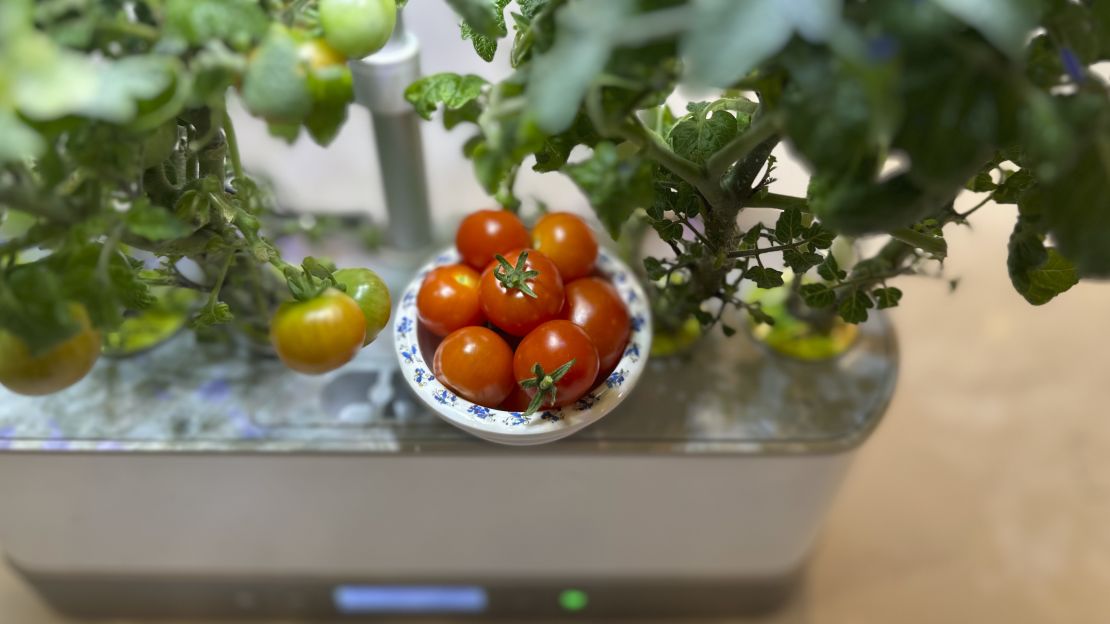
As AeroGarden notes on its website, all plants have a lifecycle, meaning they won’t continue to produce until the end of time. After a certain period, you’ll have to start fresh with new seeds. For lettuces and greens, for example, it’s about four months; tomatoes, the site says, last about 12 months. I’m about halfway through both time frames, and my plants are going strong.
If Goldilocks wanted to grow produce indoors, she might choose the AeroGarden Bounty, the perfect happy medium between the smaller-capacity Harvest and Sprout models and the larger-scale Farm models, with the bonus of WiFi compatibility and dimmable grow lights.?
Easy to clean
I was somewhat dreading the cleaning process, knowing how tedious it can be with larger and more complex indoor gardens — and I waited longer than I should have to tackle it. AeroGarden recommends cleaning the tank and replacing the water every four-to-six weeks. I went well beyond that, but mainly because my plants were growing so well with minimal issues (aside from the occasional browning leaves that I pruned as needed). Small amounts of sediment (calcium deposits from the plant food) built up along the edges of the lid, but I could quickly wipe it away. Without any obvious indications that my produce was craving a refresh, doing so slipped my mind.
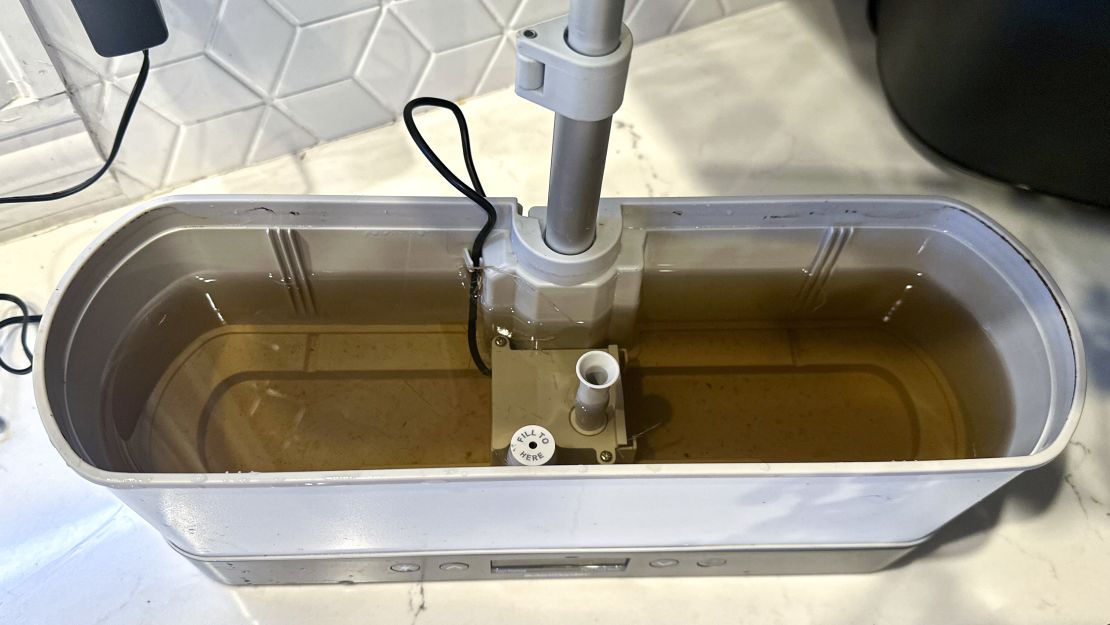
Because I waited so long, I steeled myself for a long and potentially very gross undertaking. That didn’t come to fruition. After unplugging the AeroGarden, I easily removed the upper portions of the device and placed the plants in a small bread pan for safekeeping. The water was a pale red hue (my searches in online forums led me to believe that it was from the plant food), and the tank contained minor remnants of soil, algae and some floating roots. I used water and baking soda to wipe away algae and the thin layer of grime on the inside tank walls, which took less than five minutes. The most time-consuming task was clearing the roots lodged in the pump mechanism; I used a chopstick to free them from the small crevices. Still, it wasn’t so much frustrating as it was satisfying.
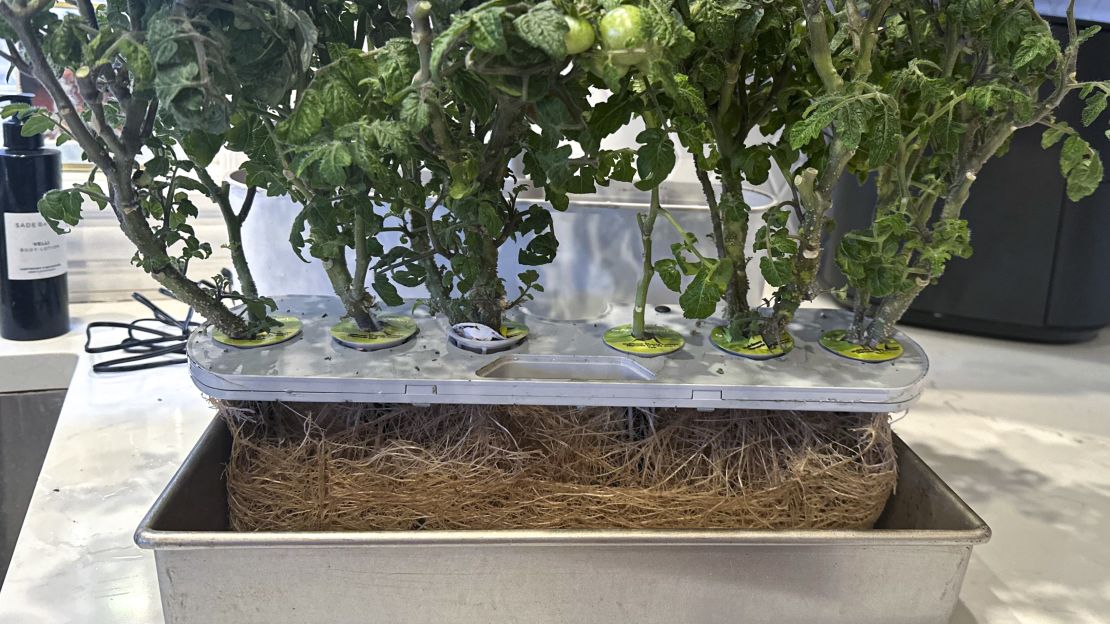
Once I completed the tank cleaning and trimmed the roots of all six tomato plants based on AeroGarden recommendations, I refilled and reset everything then did a hefty pruning to help ensure there weren’t more leaves and fruits than the water and nutrients could serve. I was a tad nervous that I had gone too far and sabotaged my harvest, but within a week or so, a fresh crop of flowers and fruits started to emerge; a few weeks later, I was noshing on a pretty healthy supply of fresh tomatoes.
Variety of device options
AeroGarden is one of those rare “something for everyone” brands. I have the six-pod Harvest Elite and the (now-discontinued) Harvest Elite Slim, both of which have small physical footprints perfect for my condo-living and two-person household. But if you want to grow more or fewer plants at once, you’re likely to find a model that suits you, from the three-pod Sprout to the nine-pod Bounty or the 12-to-24-pod Farm (the latter of which is stackable).
The seed kits also offer an array of options, including (as of publication) 8 salad kits, 18 veggie kits, 12 herbs (several of which are unique basil plants) and 5 flowers. You can order predetermined pod sets or curate a custom selection (though if you opt for the latter, you have to stick with one category, such as herbs or salads). If you want to try growing your own seeds, you can also purchase the Grow Anything Seed Pod Kit, which includes (seedless) peat moss pods, grow domes, labels and plant food. One benefit of the pre-seeded pods: AeroGarden offers a 100% germination guarantee, so they’ll replace the pods of any plants that don’t sprout within 21 days.
Whether you need to feed a large family or like to experiment with plants, the Farm 24 Basic will allow you to do so. Grow up to 24 plants under two separately adjustable LED lights, with 12 inches of vertical space, WiFi compatibility and a customizable light schedule.?
What we didn’t like about it
Lack of upfront growing tips
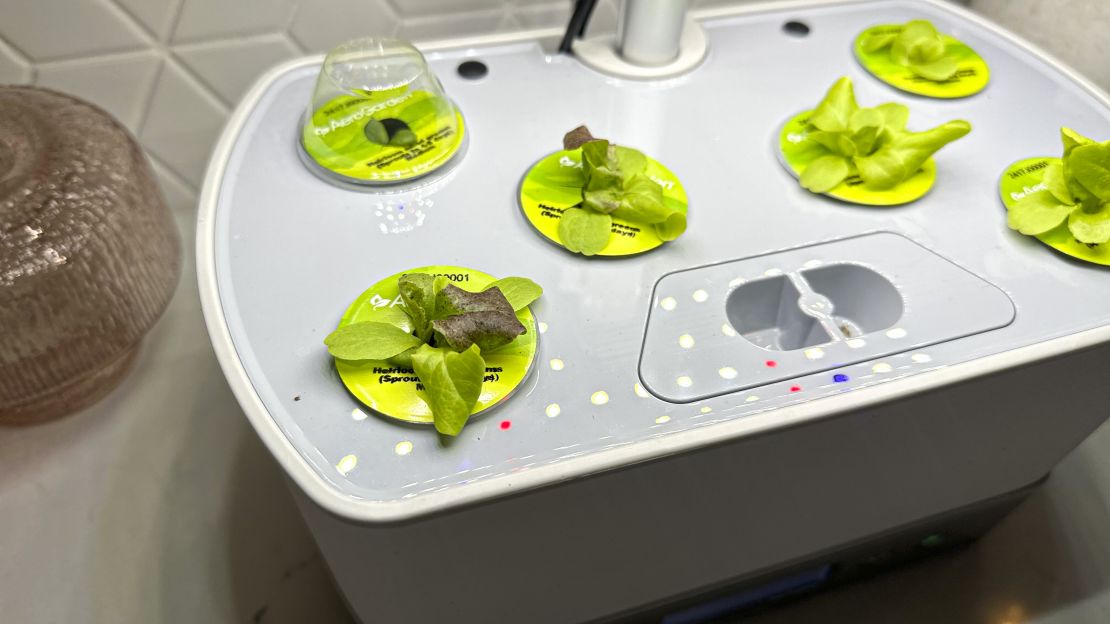
Based on my experience with other smart indoor gardens, I expected quite detailed instructions for every step of my growing process —?i.e. thin out the plants at this date, prune your leaves this much and at these intervals, trim your roots when they get this long — either via a written manual in the box or a connected app. The AeroGarden Harvest, on the other hand, came with limited written instructions for the initial set-up; the AeroGarden app is only compatible with the Bounty and Farm models, so I didn’t have one central, easy-to-access source of information about my specific garden and plants.
Initially, I resorted to Googling and searching the AeroGarden website anytime I had a question, though eventually, I found PDF manuals and guides that have proven helpful. I only wish the brand had more clearly directed me to those from the start, perhaps via a QR code on the packaging. For some, this may be fine; because I already had a baseline of knowledge from my previous indoor gardening forays, I didn’t feel that lost — but had this been my first such attempt, I would’ve been confused and overwhelmed.
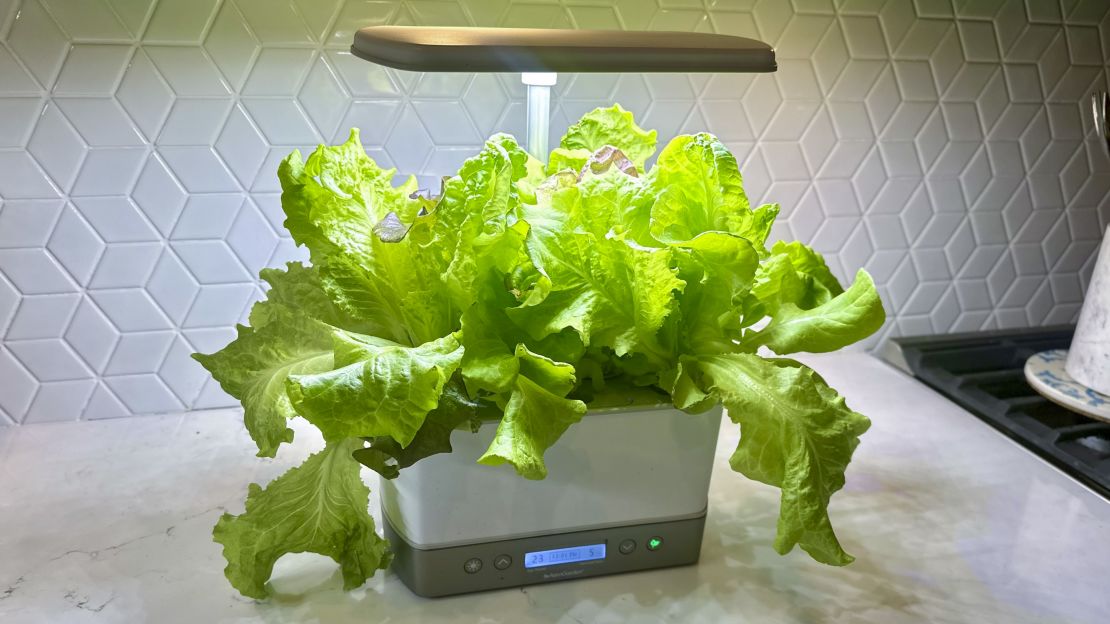
Limited harvest in small models
The six-pod AeroGarden Harvest models I have produce just the right amount of tomatoes or salad greens for my two-person household. I harvest a small handful of tomatoes once a week, and my husband and I eat them all within a day or two. That said, if we wanted a daily supply of snacking tomatoes or were making a tomato-heavy recipe, we’d need to supplement with store-bought. As for the salad greens, a full harvest looks impressively bountiful on the AeroGarden, but it’s just about enough for two dinner salads.
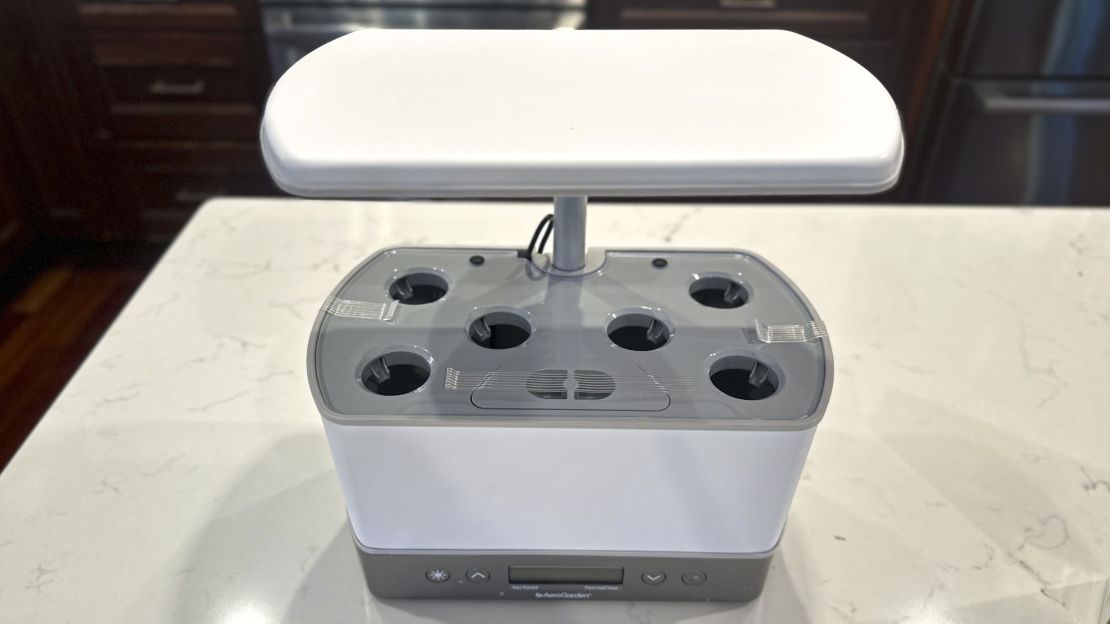
Ultimately, this setup works well for us in terms of the tomatoes — when we used to buy cherry tomatoes at the grocery store, more often than not, a portion of them would go bad before we got to them —?but the greens fall short based on our usual daily intake. My sister also previously tried a six-pod model with salad greens for her five-person household and came to a similar conclusion. She loved it when the greens reached maturity, but the excitement didn’t last long; her family went through the lettuce supply much more quickly than the plants could reproduce, and she ultimately determined it wasn’t worth it.
While it’s true these plants have lifecycles of at least a few months, to ensure the continued growth of lettuces, you shouldn’t prune more than one-third of the plant at a time — so it’s easy to hit a wall. If you’re expecting a regular, high-yield harvest, opt for a much larger AeroGarden model or a different growing method altogether.

The smaller-sized AeroGardens are better suited for plants you won’t be eating a lot of all the time. Most users will probably get the best experience growing herbs in the Harvest since one salad won’t use up your entire crop.
Sensitive water monitor
I encountered a hiccup when the AeroGarden stopped alerting me to its water needs via the button light on the front. I only realized the supply was low when the device made a subtle grinding-like sound. That continued until my first round of tank cleaning when I also trimmed my plants’ roots (officially, AeroGarden doesn’t recommend trimming roots, but I took a chance and pruned them conservatively because of the crowding) and removed ones that were stuck in the pump area. Since then, the water meter and alert mechanisms have worked just fine. I can’t say for certain the roots were the cause of the issue —?I did later see the AeroGarden website FAQ offers a separate troubleshooting tip if your water level is reading incorrectly —?but I was relieved it wasn’t a permanent defect.
Inflexible light and water schedule
As I mentioned, the AeroGarden Harvest is pre-programmed with automatic pump and light schedules (the pump is set to five minutes on and 25 minutes off, and the light is 15 hours on and 9 hours off). While it’s nice the Harvest takes care of itself in terms of ensuring appropriate water and light — the device’s turnkey nature, as I noted earlier, is one of my favorite things about it — some people could find the inflexibility of those schedules frustrating.

You can customize the light and pump timers via the AeroGarden app for Bounty and Farm devices, but the others are far more limited. With the Harvest and Sprout models, you can adjust the start time of the daily 15-hour light sessions; the Harvest Elites, Bountys and Farms also have a “Vacation Mode” setting, which reduces water usage when turned on.
The pump on the Harvest is pretty quiet —?I rarely, if ever, notice it running, and I’m almost always in the same vicinity of my garden —?but the light is bright, which could easily be an annoyance or disturbance depending on where your device is located.
Bottom line
There’s an increasing number of home hydroponics devices to choose from these days, but if you’re new to the indoor gardening scene (or gardening in general, for that matter), AeroGarden is a fantastic option. The brand offers a variety of models, including small devices at reasonable price points, without overly complicated setup or maintenance requirements. Sure, it would be nice to have more control over the automated aspects of certain AeroGardens, but if you’re not picky about when the bright LEDs light up your plants and the surrounding area, I don’t think it should be a deal breaker. If you put thought into the right model and size for you and your household before buying, you could be looking at your new favorite produce source.






















